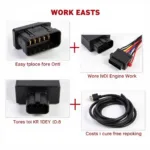One of the most common questions car owners have about OBD2 scanners is whether their vehicle needs to be running for the scanner to work. The answer, like many things in the automotive world, is: it depends.
Let’s clear up the confusion and shed some light on when your car needs to be on for OBD2 diagnostics.
Understanding Your Car’s OBD2 System
Your car’s On-Board Diagnostics II (OBD2) system is like its own internal mechanic. It continuously monitors various systems within your vehicle, looking for malfunctions. When it detects an issue, it stores a trouble code in its memory.
An OBD2 scanner acts as the translator, allowing you to read these codes and understand what might be going on. But to access this information, the scanner needs power.
Powering Your OBD2 Scanner
Most OBD2 scanners get their power directly from your car’s battery through the OBD2 port itself. This means you usually don’t need your engine running for basic diagnostics.
However, there are situations where you might need to turn your key to the “on” position (without starting the engine) or even have the engine running:
-
Accessing Live Data: To see real-time information from your car’s sensors, such as engine speed, coolant temperature, or oxygen sensor readings, the engine often needs to be running. This is because some sensors only transmit data when the car is operational.
-
Performing Special Functions: Certain advanced OBD2 scanners can perform special functions, like resetting the check engine light, performing component tests, or even programming new keys. These functions typically require more power and communication with the car’s computer, necessitating the engine to be on.
When to Keep Your Engine Off
While there are times you may need the engine on, there are also scenarios where it’s best to have it off:
-
Reading and Clearing Codes: If you only need to read and clear basic diagnostic trouble codes, your engine can usually remain off. The scanner will still be able to communicate with your car’s computer and retrieve the necessary information.
-
Battery Concerns: If you’re concerned about your car battery draining, it’s best to read codes with the engine off. Modern OBD2 scanners are designed to have minimal power draw, but keeping the engine off eliminates any potential risk.
Tips for Using an OBD2 Scanner
Here are some additional tips for effectively using an OBD2 scanner:
-
Consult Your Owner’s Manual: Always refer to your vehicle’s owner’s manual for specific instructions regarding OBD2 diagnostics.
-
Use a Quality Scanner: Invest in a reputable OBD2 scanner that is compatible with your vehicle’s make and model. A quality scanner will provide accurate readings and offer more functionality.
-
Start with the Basics: If you’re new to OBD2 scanners, begin with basic functions like reading and clearing codes before exploring advanced features.
-
Seek Professional Help When Needed: If you’re unsure about any aspect of using an OBD2 scanner or encounter persistent issues, don’t hesitate to consult a qualified mechanic.
Conclusion
In most cases, your car doesn’t need to be running for basic OBD2 diagnostics. However, certain functions, like viewing live data or performing special tasks, may require turning the key to the “on” position or even starting the engine.
By understanding when your car needs to be on for OBD2, you can confidently use your scanner to diagnose problems, monitor your vehicle’s health, and potentially save yourself a trip to the mechanic.
Need help choosing the right OBD2 scanner for your Apple device? Check out our selection of OBD2 scan tools for Apple.
FAQs
1. Can I damage my car by using an OBD2 scanner?
Using an OBD2 scanner correctly will not harm your vehicle. However, it’s crucial to choose a compatible scanner and follow the manufacturer’s instructions to avoid any potential issues.
2. What do I do after reading a trouble code?
Once you’ve read a trouble code, it’s best to research its meaning and potential causes. You can then decide whether to attempt a repair yourself or consult a qualified mechanic.
3. Can an OBD2 scanner tell me everything that’s wrong with my car?
While OBD2 scanners are valuable diagnostic tools, they don’t provide a complete picture of your car’s health. They primarily focus on emissions-related systems and may not detect all mechanical or electrical issues.
4. How often should I use an OBD2 scanner?
It’s a good practice to scan your vehicle for codes periodically, especially if you notice any unusual performance or warning lights. Regular checks can help catch problems early on.
5. Can I use an OBD2 scanner on any car?
OBD2 scanners are designed to work with most cars manufactured after 1996. However, there might be variations in protocols and connector types depending on the make and model.
Looking for the best OBD2 apps for your Apple device? Explore our recommendations for the best OBD2 app for Apple.
Still have questions about your car’s OBD2 system? Our team of car diagnostics experts is here to help! Contact us via WhatsApp at +1(641)206-8880 or email us at [email protected]. We offer 24/7 support to answer all your questions.


